Bath and North East Somerset
Explore hidden histories, historic photos, and things you never knew about Bath and North East Somerset from the collections and archives of Historic England.
Discover your local listed buildings and places
Introducing some of Bath and North East Somerset's most historic sites, included in the National Heritage List for England. Some of these captions have been summarised by AI. Click through for the official List entry. Skip this section and go to place by numbers
City of Bath
Charlcombe
The official listing for all World Heritage sites is held by UNESCO and can be found on their website.
Gardens at Oakwood/bathwick Tower and Smallcombe House
Bath
An early-C19 villa garden created by the painter Benjamin Barker, further improved in the early 1830s following alterations to the villa by the architect Edward Davis.
Newton Park
Corston
Newton Park, an 18th-century landscape by Lancelot Brown and later Humphry Repton, surrounds a historical house now serving Bath Spa University College.
Battle of Lansdown (Hill) 1643
Bitton
The Battle of Lansdown Hill in 1643 was a key conflict during the Civil Wars, where Royalists sought control but faced stalemate against Parliamentarians near Bath.
Nos. 1-30, ROYAL CRESCENT
Bath
Royal Crescent in Bath features 30 finely cut limestone houses in a grand crescent, designed by John Wood the Younger between 1767 and 1775.
St Catherine's Court
St. Catherine
St Catherine's Court features 17th-century terraced gardens surrounding a historic house. John Harrington, associated with inventing the water closet, once owned the property.
Nos. 1-41 and Attached Area Railings
Bath
Grosvenor Place, designed by John Eveleigh between 1791 and 1819, features limestone terraced houses turned into flats or commercial premises, showcasing Georgian architecture with notable...
Rainbow Wood House
Bath
A small country house of 1897, built in the Jacobean style to the designs of Silcock & Reay for W. E. Mallett Esq. Read the official list entry to find out more.
Twerton Wood Tunnel West Portal (MLN110915)
Bath
A railway tunnel portal in a monumental castellated Gothic style, set in a short, broad cutting that flattens out westward.
Twerton Viaduct, the Old Station House and Nos 1 to 13 th…
Bath
A railway viaduct incorporating a station building, arches and workers houses, completed in 1840 for the Great Western Railway to a design by Isambard Kingdom Brunel.
The Centurion Public House
Bath
A public house built in 1965-1966 to the designs of HR Robinson of West Country Breweries and JF Lachlan of Whitbread's on a sloping site in a housing estate, with extensive views.
Pulteney Bridge
Bath
Pulteney Bridge, designed by Robert Adam from 1769-1774 for William Johnstone Pulteney, features shops on both sides and exemplifies Neoclassical architecture with Palladian influences.
Skew Bridge and Associated Cantilevered Walkway Immediate…
Bath
Railway bridge, built in 1840 to the designs of Isambard Kingdom Brunel for the Great Western Railway.
Wellow Signal Box
Wellow
A signal box, built in 1892 for the Somerset and Dorset Joint Railway; closed in 1966, and subsequently briefly used as an artist's studio and converted to accommodation and extended in the...
Pavilion
Bath
A former gardener's cottage or lodge, later a cloakroom and pavilion, dating from c.1840. Read the official list entry to find out more.
Claverton Manor
Claverton
Claverton Manor, located near Bath, features early 19th-century gardens and pleasure grounds, and houses the American Museum. The estate blends historic architecture with scenic parkland.
53-65 Great Pulteney Street and attached lamp standards t…
Bath
This is a historical example of late 18th-century urban architecture in Bath, designed by Thomas Baldwin and John Eveleigh. Notables like Bishop Thirlwall and Napoleon III were residents.
Oakwood and Bathwick Tower
Bath
A large detached villa set in landscaped grounds, built in circa 1814, aggrandised in circa 1833 by Edward Davis, and altered in circa 1879 by Gill & Browne and again in circa 1896 by JM...
The Waldegrave Arms, East Harptree
East Harptree
An inn, probably formerly a late-medieval church house of C15/C16 date with a later wing of probable C17 date. Read the official list entry to find out more.
The Ralph Allen Town House
Bath
A part of the former town house of Ralph Allen created in 1727, with possibly earlier origins, in a highly decorative Palladian style attributed to John Wood the Elder.
Prior Park
Bath
Prior Park, designed with input from Alexander Pope and Lancelot Brown, is an 18th-century landscape park centered around a Palladian house, now a school, with gardens restored by the...
Large univallate hillfort with a bowl barrow and pillow m…
North Stoke
Large univallate hillforts were significant Iron Age structures used for defense and social display, serving as regional centers in southern England.
Wansdyke: section 1230yds (1120m) eastwards from Burnt Ho…
Southstoke
Linear boundaries like the Wansdyke were constructed by large social groups as territorial markers, displaying prestige and holding archaeological and historical significance.
No 18, Queen Square
Bath
No.18 Queen Square, designed by John Pinch II in 1830, is a Greek Revival building of historical significance, formerly the Bath Reference Library, now housing the Bath Royal Literary and...
Kelston Park
Kelston
Kelston Park, developed by Lancelot Brown in the 18th century, features expansive parkland and a manor house originally built by the Harrington family, later transformed by Sir Caesar...
Mount Rose, No. 31 Oldfield Road
Bath
An early-C19 villa with good detailing. Read the official list entry to find out more.
The Herman Miller Factory
Bath
A factory built in 1976-7 to a design by Nicholas Grimshaw of Farrell & Grimshaw Architects, for the American furniture company Herman Miller Inc.
St James' Viaduct (MLN110705)
Bath
A viaduct, incorporating spans over roads, built in 1840, by engineer I.K. Brunel for the Great Western Railway. It is also referred to as Holloway Viaduct and Southgate Viaduct.
Sydney Gardens
Bath
Sydney Gardens, designed in the late 18th century as pleasure grounds, became a public park in 1913. Features include the Holburne Museum and historically significant structures and canals.
Royal Victoria Park
Bath
A public park laid out to a design by Edward Davis and opened by Princess Victoria in 1830. Read the official list entry to find out more.
Palladian Bridge in Grounds of Prior Park
Bath
The Palladian Bridge at Prior Park, built in 1755 by Richard Jones, is a significant visual landmark in the historic landscape designed with advice from Alexander Pope and John Wood the...
Nos. 5-11 (Consec) Francis Hotel
Bath
Nos. 5-11 Francis Hotel in Queen Square, designed by John Wood the Elder, was reconstructed post-war due to bomb damage.
Holy Trinity Church
Bath
Church built in 1873-1874, extended in 1880, in C13 French Gothic style. By Wilson, Willcox and Wilson. Read the official list entry to find out more.
Lansdown Cemetery and Beckford's Tower
Bath
A cemetery consecrated in 1848, incorporating features of a former pleasure ground and ride created by William Beckford and the architect Henry Edmund Goodridge in c 1825-7.
66-77, Great Pulteney Street
Bath
Great Pulteney Street, designed by Thomas Baldwin and colleagues, features Georgian architecture. Notable residents included William Beckford and Hannah More.
Keynsham Abbey Remains to the South of Number 3 (Number 3…
Keynsham
The remains of Keynsham Abbey, founded around 1170 for Augustinian Canons, were dissolved in 1539. It includes finely dressed ashlar and 12th-century architectural details.
23-37 (Consec) And Attached Railings
Bath
Built in the late 18th century by John Palmer, these houses are significant as part of Bath's urban design, hosting notable residents like Walter Savage Landor.
Explore more
Search for more listed placesBath and North East Somerset through time
This timeline shows the first period of use for buildings and places on the National Heritage List for England, just one of the details recorded for every list entry. Click around to see how Bath and North East Somerset changes over time. Skip this section and go to aerial photos
Prehistoric Before AD 43
Prehistory covers a million years of human occupation before the Roman invasion and the introduction of writing. Primarily hunter-gatherers of several human species including Neanderthals, the peoples moved across Europe, hunting animals, exchanging ideas and developing complex culture and belief systems including burial rites and astronomical understanding, as at Stonehenge for example.
Roman AD 43 to AD 410
Britain was invaded by four legions of the Roman army in AD 43, who relatively rapidly conquered England from landing points in Kent. Parts of Wales and Scotland soon followed.
Roman culture brought urbanism, monumental buildings, wide-ranging religious beliefs, writing, and strong social hierarchy. The Roman administrative system was withdrawn in AD 410.
Early medieval AD 410 to AD 1066
This period, often associated in England with Anglo-Saxons and Vikings, saw a reduction in urban living from the Roman period and increased migration from northern Europe.
Traces of this period can be found in cemeteries, particularly in artefacts and in some of the very early churches, as this period also saw the growth of Christianity in Britain.
Medieval AD 1066 to AD 1540
This period, sometimes known as the Middle Ages, began with the Norman invasion in AD 1066. It saw a significant rise in military and defensive buildings such as castles and earthworks, as well as religious houses dominating a largely agricultural landscape.
The monarchy and Church dominated the period, which also saw the break with the Roman Catholic Church and the English reformation.
Post medieval AD 1540 to AD 1901
The Post-Medieval period brought seismic changes to life in England, with religious reformation leading to the democratization of worship and the destruction of hundreds of religious houses.
In parallel, there was a huge expansion of scientific study and enlightenment that permanently altered the nation's social structure and landscape. Industrialization and mass production lead to wider global trade, emigration, and immigration.
20th century AD 1901 to AD 2000
The 20th century saw an incredible expansion of England's transport networks, with suburban growth shadowing rapid infrastructural expansion. The establishment of state schools, hospitals, and modern technical colleges, with new architectural styles, radically changed the appearance of towns and cities.
Two catastrophic world wars and the 1918 pandemic also brought unprecedented change, altering England's built environment and social structures forever.
Prehistoric Before AD 43
Prehistory covers a million years of human occupation before the Roman invasion and the introduction of writing. Primarily hunter-gatherers of several human species including Neanderthals, the peoples moved across Europe, hunting animals, exchanging ideas and developing complex culture and belief systems including burial rites and astronomical understanding, as at Stonehenge for example.
Roman AD 43 to AD 410
Britain was invaded by four legions of the Roman army in AD 43, who relatively rapidly conquered England from landing points in Kent. Parts of Wales and Scotland soon followed.
Roman culture brought urbanism, monumental buildings, wide-ranging religious beliefs, writing, and strong social hierarchy. The Roman administrative system was withdrawn in AD 410.
Early medieval AD 410 to AD 1066
This period, often associated in England with Anglo-Saxons and Vikings, saw a reduction in urban living from the Roman period and increased migration from northern Europe.
Traces of this period can be found in cemeteries, particularly in artefacts and in some of the very early churches, as this period also saw the growth of Christianity in Britain.
Medieval AD 1066 to AD 1540
This period, sometimes known as the Middle Ages, began with the Norman invasion in AD 1066. It saw a significant rise in military and defensive buildings such as castles and earthworks, as well as religious houses dominating a largely agricultural landscape.
The monarchy and Church dominated the period, which also saw the break with the Roman Catholic Church and the English reformation.
Post medieval AD 1540 to AD 1901
The Post-Medieval period brought seismic changes to life in England, with religious reformation leading to the democratization of worship and the destruction of hundreds of religious houses.
In parallel, there was a huge expansion of scientific study and enlightenment that permanently altered the nation's social structure and landscape. Industrialization and mass production lead to wider global trade, emigration, and immigration.
20th century AD 1901 to AD 2000
The 20th century saw an incredible expansion of England's transport networks, with suburban growth shadowing rapid infrastructural expansion. The establishment of state schools, hospitals, and modern technical colleges, with new architectural styles, radically changed the appearance of towns and cities.
Two catastrophic world wars and the 1918 pandemic also brought unprecedented change, altering England's built environment and social structures forever.
Aerial photos of Bath and North East Somerset
Aerial photography helps reveal secrets of England's changing landscapes that are impossible to see from the ground. Skip this section and go to archive images

Bath
Queen Square and environs, Bath, 1920

Bath
The Recreation Ground and the city, Bath, 1974
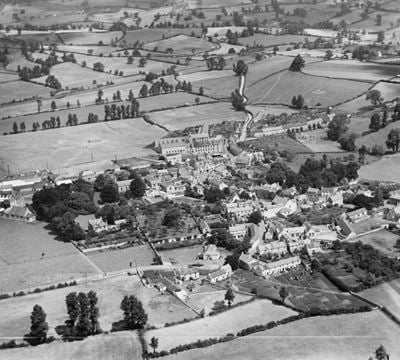
Paulton
The village, Paulton, 1930

Paulton
Purnell and Sons Ltd Printing Works, Paulton, 1952
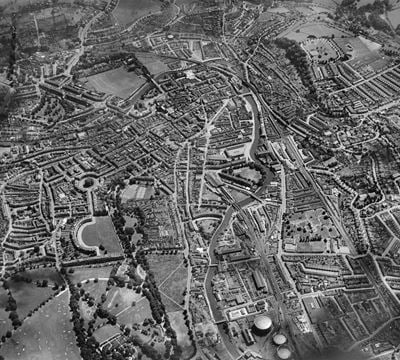
Bath
The city, Bath, 1935

Bath
Industry at Bath Riverside including the Victoria Works and Avonbank Works, Bath, 1946

Midsomer Norton
F. Pratten & Co Horticultural Builders Works, Midsomer Norton, 1933
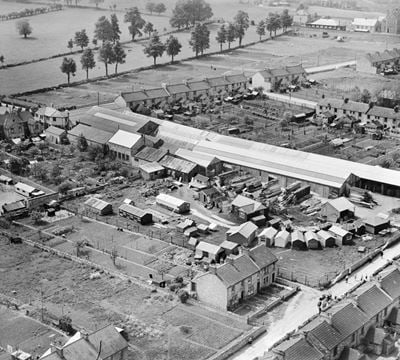
Midsomer Norton
F. Pratten & Co Horticultural Builders Works, Midsomer Norton, 1933
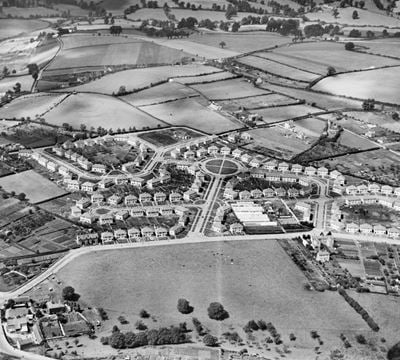
Bath
Southdown, Bath, 1928
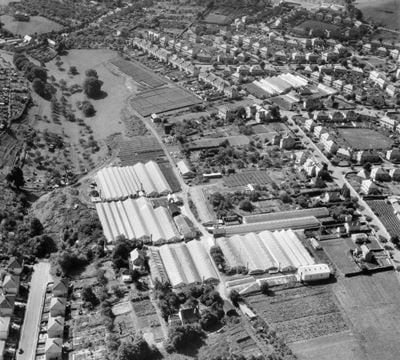
Southdown
Nursery between Southdown Road and Coronation Avenue, Southdown, 1950
Bath and North East Somerset in the Historic England Archive
The Historic England Archive cares for over 15 million images, dating from the 1850s to the present day. Discover stunning images of Bath and North East Somerset's past. Skip this section and go to stories about heritage
Charles George Harper Collection
Bath, Bath And North East Somerset
Date created: 1892 - 1933
The west front of Bath Abbey
Eric de Mare
Bath, Bath And North East Somerset
Date created: 1945 - 1980
Exterior view of the front of Holburne Museum in Bath.
London, Midland and Scottish Railway Company
Midford, Bath And North East Somerset
Date created: Jul 1898
A view looking north-west from Midford Road towards the railway line and houses on the hill, with two men in a horse-drawn cart about to cross the...
Nigel Temple Collection of Postcards of Parks and Gardens
Bath, Bath And North East Somerset
Date created: 1902 - 1907
GENERAL VIEW SHOWING THE TITIAN JUPITER
Walter Scott
Bath, Bath And North East Somerset
Date created: Sep 1946
A view looking north-east down Holloway towards St Mark's parish hall, from east of the junction with Old Orchard, with the Royal Hotel visible in the...
Charles George Harper Collection
Bath And North East Somerset
Date created: 1892 - 1933
A view from the north-west of Sham Castle
Eric de Mare
Bath, Bath And North East Somerset
Date created: 1945 - 1980
Exterior view of the Garricks Head public house in Bath showing the pub entrance with a theatre stall entrance visible in the foreground.
London, Midland and Scottish Railway Company
Midford, Bath And North East Somerset
Date created: 13 Jul 1898
A view looking east across Midford from the platform of the railway station
Nigel Temple Collection of Postcards of Parks and Gardens
Bath, Bath And North East Somerset
Date created: 1900 - 1950
VIEW LOOKING TOWARDS THE OBELISK
Walter Scott
Bath, Bath And North East Somerset
Date created: Sep 1946
A view of the gatehouse and bridge from the south on Trim Street, with Queen Street beyond
London, Midland and Scottish Railway Company
Widcombe, Bath, Bath And North East Somerset
Date created: Sep 1921
An elevated view looking east across Widcombe from Alexandra Park
Nigel Temple Collection of Postcards of Parks and Gardens
Bath, Bath And North East Somerset
Date created: 1903 - 1908
GENERAL VIEW ACROSS THE PARK
Stories about heritage in your local area
Historic England publishes news, blogs, research, videos, and podcasts celebrating England's rich heritage. Discover the stories we have about Bath and North East Somerset. Skip this section and go to education
What Is the Oldest House in England?
Mentions Saltford Manor House
Discover when the oldest house in England was built. The earliest domestic house, Saltford Manor House, could date from the 12th century.
5 Things to Know About Coronations
Mentions Abbey Church of St Peter and St Paul
Discover the history and heritage behind the ancient English coronation ceremony.
The Bennets, the Bridgertons, and Now You: Assembly Rooms Past and Present
Mentions Grand Pump Room
Regency romance has returned to our screens with the likes of Bridgerton and a flurry of Austen adaptions.
Lifting the Curtain: Theatre Then and Now
Mentions Theatre Royal and Former Garrick's Head Public House
British theatre originated in the medieval era, with a strongly religious influence.
10 Brilliant Historic Bookshops
Mentions Bayntun's Bookshop
We love any excuse to celebrate a bookshop, with their comforting atmosphere and wonderful smell. Here are some highlights from around the country.
Pubs, Parks and Pavilions: Victoria in Public Places
Mentions Royal Victoria Park
Here are just some of the historic public places in England named after Queen Victoria.
10 of England’s Best Post-War Pubs
Mentions The Centurion Public House
More public houses were built in the years 1945-1985 than in any other period in English history, yet pubs of these years are now highly threatened.
5 Stellar Women of Space Science
Mentions 18 and 19 and Attached Railings
To mark International Women’s Day 2017, we’ve collaborated with The Royal Society to celebrate and record the stories of groundbreaking women of...
Tall Tales From 6 Unusual Monastic Sites
Mentions Site of correrie or lower house to Hinton Priory
Monastic sites help tell the story of English Christianity through fourteen centuries.
9 Inspirational Settings for World Book Day
Mentions Grand Pump Room
This morning, thousands of Harry Potters, Peppa Pigs and Matildas were dispatched to schools around the country to mark World Book Day.
Rare Second World War Command Post and London War Memorial Listed to Celebrate VE Day
Mentions Obelisk
Unusual Second World War battle headquarters and war memorial which commemorates civilian casualties among the British war dead listed.
Heritage at Risk 2019
Mentions Beckford's Tower With Attached Wall and Railings
Historic England has revealed the historic sites most at risk of being lost forever as a result of neglect, decay or inappropriate development.
Five Quirky Post-War Pubs Listed
Mentions The Centurion Public House
Five quirky post-war pubs have been listed on the advice of Historic England.
Bath and North East Somerset's social history through photos
Over 10,000 images from the Historic England Archive have been specially selected and re-captioned for teachers, students, and anyone who wants to learn more about their local area. Skip this section and go to grant-aided places
Village Clock Tower, High Street, East Harptree, Bath and North East Somerset
Period: Victorian (1837 - 1901)
The village clock tower was put up to commemorate Queen Victoria's Diamond Jubilee in 1897 and was designed in Arts and Crafts style.
Village Clock Tower, High Street, East Harptree, Bath and North East Somerset
Tower House, Bath Road, Kelston, Bath and North East Somerset
Period: Georgian (1714 - 1836)
Tower House was built as a dower house for the Kelston Park estate.
Tower House, Bath Road, Kelston, Bath and North East Somerset
Tithe Barn, Dovecote and Horse Engine-House, Southstoke, Bath and North East Somerset
Period: Medieval (Middle Ages) (1066 - 1484)
The tithe barn dates from the 15th century and was used for keeping the tithe or tenth of the produce from local farms that was paid to the church or...
Tithe Barn, Dovecote and Horse Engine-House, Southstoke, Bath and North East Somerset
The Old Brewery, Freshford, Bath and North East Somerset
Period: Victorian (1837 - 1901)
The brewery with its chimney was built in the early 19th century and is a very important village landmark.
The Old Brewery, Freshford, Bath and North East Somerset
The Cross Bath, Bath Street, Bath, Bath and North East Somerset
Period: Georgian (1714 - 1836)
One of the baths in the city providing access to the mineral waters for swimming and health treatments.
The Cross Bath, Bath Street, Bath, Bath and North East Somerset
Temple Cloud Court House, Temple Cloud, Cameley, Bath and North East Somerset
Period: Victorian (1837 - 1901)
The Court House was built in 1857 in Jacobean style as a Divisional Magistrates’ Court and Police Station.
Temple Cloud Court House, Temple Cloud, Cameley, Bath and North East Somerset
St Martin's Hospital, Midford Road, Bath, Bath and North East Somerset
Period: Georgian (1714 - 1836)
The workhouse was built in 1836-8 to a Y-shaped design by Sampson Kempthorne on a site to the south of the city.
St Martin's Hospital, Midford Road, Bath, Bath and North East Somerset
Sir Bevill Grenville's Monument, Lansdown, Bath, Bath and North East Somerset
Period: Stuart (1603 - 1713)
This monument was erected in Lansdown to commemorate the heroism of the Royalist leader, Sir Bevill Grenville, killed at the Battle of Lansdown in...
Sir Bevill Grenville's Monument, Lansdown, Bath, Bath and North East Somerset
Discover more
Ready for more local heritage? Take a look at these other places nearby


